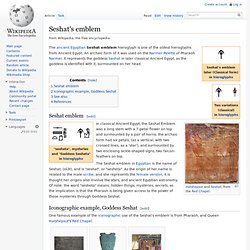

EGYPT 232 - MAAT & SESHAT *Egyptian Goddesses II * (by Egyptahotep) Seshat, Ancient Egyptian Goddess of Writing and Measurement. ByCaroline SeawrightJuly 30, 2001 Updated: November 29, 2012 9 Comments Seshat (Sashet, Sesheta, Sesat), meaning 'female scribe', was seen as the goddess of writing, historical records, accounting and mathematics, measurement and architecture to the ancient Egyptians.

She was depicted as a woman wearing a panther-skin dress (the garb of the funerary stm priests) and a headdress that was also her hieroglyph ( ) which may represent either a stylised flower or seven (or nine) pointed star on a standard that is beneath a set of down-turned horns. (The horns may have originally been a crescent, linking Seshat to the moon and hence to her spouse, the moon god of writing and knowledge, Thoth.) She was believed to appear to assist the pharaoh at various times, and who kept a record of his life: It was she who recorded the time allotted to him by the gods for his stay on earth. -- Mysteries in Stone, Seshat -- Cyril Fagan (1951), Zodiacs Old and New: A Probe Into Antiquity and What Was Found, p. 15.
Seshat's emblem. The ancient Egyptian Seshat emblem hieroglyph is one of the oldest hieroglyphs from Ancient Egypt.

An archaic form of it was used on the Narmer Palette of Pharaoh Narmer. It represents the goddess Seshat in later classical Ancient Egypt, as the goddess is identified with it, surmounted on her head. Seshat emblem[edit] In classical Ancient Egypt, the Seshat Emblem was a long stem with a 7-petal flower on top and surmounted by a pair of horns; the archaic form had six petals, (as a vertical, with two crossed lines, as a 'star'), and surmounted by two enclosing sickle-shaped signs, two falcon-feathers on top. Iconographic example, Goddess Seshat[edit] One famous example of the iconographic use of the Seshat's emblem is from Pharaoh, and Queen Hatshepsut's Red Chapel.
Obverse-(front), Pharaoh Narmer's paletteUshabti box with hieroglyphs of Seshat's emblem See also[edit] Gardiner's Sign List#R. References[edit] Budge. Seshat. Henadology. Seshat is the divine patroness of scribes—her name simply means ‘the Scribe’ or ‘the Writer’—and is closely linked to Thoth.

Egyptians distinguished conceptually between “words” (mdw) and “writing” (drf or sesh). Thoth, although ultimately responsible for both, is associated more strictly with the former and Seshat with the latter (Saleh 1969, 24). Seshat is regarded as the inventor both of writing, of reckoning, especially in the archaic form of notching palm-leaf stalks, and measurement in general—she “reckons all things on earth” (Edfou I, 291). In CT spell 10, Seshat is said to open the portal of the netherworld for the deceased, in which we may understand the ‘portal’ in question to be the successful mastery of ritual under Seshat’s guidance.
A similar interpretation can be assumed for phrases such as “your mother Seshat clothes you,” (CT spell 68). In the fragmentary demotic composition which has been labelled the “Book of Thoth” (trans. See also: Allen, T. Seshat The Egyptian Goddess. Areas of Influence: Seshat was associated with the written word.

She invented writing and kept the records of the ancient Pharaoh’s. Seshat. Ancient Egypt: the - Seshat. (Seshet, Sesheta) Symbols: seven-pointed star or flower atop a pole, palm branch, writing pen and palette, papyrus scrolls and books.

Seshat, Female Scribe, Goddess of Writing Measurement, A Feature Tour Egypt Story. Gods of Ancient Egypt: Seshat. Seshat (Sesha, Sesheta or Safekh-Aubi) was a goddess of reading, writing, arithmetic and architecture who was seen as either the female aspect of Thoth, his daughter or his wife.

They had a child called Hornub. This actually means "gold Horus", so Seshat was sometimes associated with Isis. She was the scribe of the pharaoh, recording all of his achievements and triumphs including recording both the booty and the captives taken in battle. She was also thought to record the actions of all people on the leaves of the sacred persea tree. She was known by the epithet "Mistress of the House of Books" because she looked after the library of the gods and was the patron of all earthly libraries. She was also given the epithet "Mistress of the House of Architects" and from at least the Second Dynasty she was associated with a ritual known as "pedj shes" ("stretching the cord") which was conducted during the laying of the foundations of stone buildings. Copyright J Hill 2010.
Seshat. In Egyptian mythology, Seshat (also spelled Safkhet, Sesat, Seshet, Sesheta, and Seshata) was the Ancient Egyptian goddess of wisdom, knowledge, and writing.

She was seen as a scribe and record keeper, and her name means she who scrivens (i.e. she who is the scribe), and is credited with inventing writing.